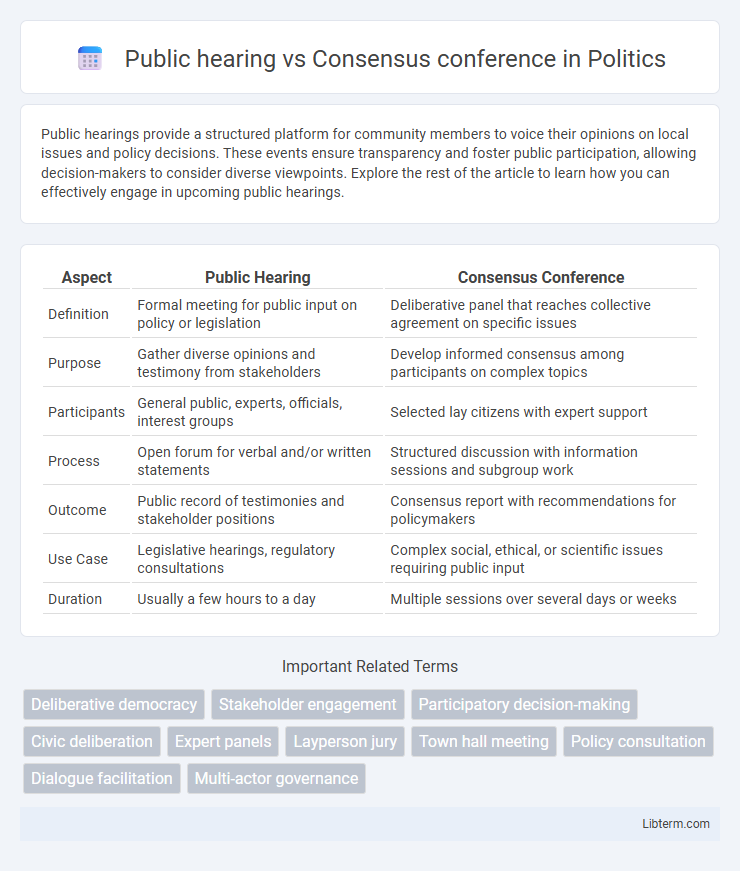Public hearings provide a structured platform for community members to voice their opinions on local issues and policy decisions. These events ensure transparency and foster public participation, allowing decision-makers to consider diverse viewpoints. Explore the rest of the article to learn how you can effectively engage in upcoming public hearings.
Table of Comparison
| Aspect | Public Hearing | Consensus Conference |
|---|---|---|
| Definition | Formal meeting for public input on policy or legislation | Deliberative panel that reaches collective agreement on specific issues |
| Purpose | Gather diverse opinions and testimony from stakeholders | Develop informed consensus among participants on complex topics |
| Participants | General public, experts, officials, interest groups | Selected lay citizens with expert support |
| Process | Open forum for verbal and/or written statements | Structured discussion with information sessions and subgroup work |
| Outcome | Public record of testimonies and stakeholder positions | Consensus report with recommendations for policymakers |
| Use Case | Legislative hearings, regulatory consultations | Complex social, ethical, or scientific issues requiring public input |
| Duration | Usually a few hours to a day | Multiple sessions over several days or weeks |
Definition of Public Hearing
A public hearing is a formal meeting organized by government bodies or agencies to gather input from citizens on proposed policies, regulations, or projects. It offers a structured platform for stakeholders to present their opinions, ensuring transparency and public participation in decision-making processes. Unlike consensus conferences, which emphasize collaborative deliberation among selected participants, public hearings are open forums aimed primarily at information collection and community feedback.
Definition of Consensus Conference
A Consensus Conference is a participatory method where a diverse group of laypeople engage with experts to deliberate and provide informed recommendations on complex scientific or technological issues. Unlike a Public Hearing, which primarily gathers public opinions in a formal setting, a Consensus Conference emphasizes collaborative dialogue and mutual understanding to reach a shared agreement. This process fosters democratic participation and enhances the legitimacy of policy decisions by integrating informed citizen perspectives.
Historical Background of Both Approaches
Public hearings originated in the early 20th century as a governmental tool to involve citizens in decision-making processes, promoting transparency and accountability. Consensus conferences emerged in Denmark during the 1980s as a participatory method designed to integrate scientific expertise with public values, emphasizing informed deliberation among lay participants. Both approaches reflect evolving democratic practices aimed at enhancing public engagement but differ in structure and historical context.
Key Objectives: Public Hearing vs Consensus Conference
Public hearings primarily aim to collect diverse stakeholder opinions and provide a transparent forum for public input on policy decisions. Consensus conferences focus on fostering expert and layperson collaboration to achieve a shared, well-informed agreement on complex scientific or technical issues. Both methods seek to enhance democratic engagement but differ in depth of deliberation and decision-making outcomes.
Participant Selection and Roles
Public hearings typically involve open participation where any member of the public can attend and provide input, often resulting in a broad representation of views but limited interaction among participants. Consensus conferences select a diverse, representative panel of lay citizens who actively engage in structured deliberation, guided by experts, to reach a collective agreement on complex issues. The key distinction lies in public hearings favoring inclusive attendance with passive roles, while consensus conferences emphasize selective participant recruitment and collaborative decision-making.
Process and Structure Comparison
Public hearings feature a one-way communication process where experts or officials present information to a large audience, emphasizing transparency and public input through comments or questions. Consensus conferences involve a structured, multi-stage process, including expert presentations, citizen deliberation, and consensus-building to produce collective recommendations. Unlike public hearings, consensus conferences prioritize informed dialogue among a small, diverse group to reach agreement on complex policy or scientific issues.
Decision-Making Mechanisms
Public hearings facilitate decision-making by allowing stakeholders and the general public to voice opinions and provide input on policy proposals, ensuring transparency and inclusivity. Consensus conferences emphasize collaborative decision-making by bringing together diverse experts and citizens to deliberate and formulate collective recommendations, enhancing mutual understanding and legitimacy. Both mechanisms aim to incorporate multiple perspectives but differ in structure, with public hearings being more open-ended and consensus conferences requiring structured dialogue and agreement.
Transparency and Public Engagement
Public hearings provide a transparent platform where stakeholders can openly express their views, ensuring accessibility and accountability in decision-making processes. Consensus conferences engage a diverse group of lay citizens, promoting deeper public engagement through informed deliberation and collaborative problem-solving. Both formats enhance transparency but differ in interaction level, with public hearings being more open-ended and consensus conferences emphasizing structured dialogue.
Advantages and Limitations of Each Method
Public hearings offer a transparent platform for diverse stakeholder input, promoting inclusivity and public accountability but often face challenges with limited depth in discussion and potential dominance by outspoken individuals. Consensus conferences provide structured, in-depth deliberation among selected experts and lay participants, enhancing informed decision-making and collaborative solutions, yet they require significant time and resource commitments and may lack broad stakeholder representation. Balancing the advantages and limitations of both methods depends on the specific goals, scale, and context of the policymaking or research process involved.
Practical Applications and Case Studies
Public hearings facilitate direct stakeholder input and are widely used in environmental policy debates, such as the U.S. EPA's Clean Air Act amendments, allowing affected communities to voice concerns and influence regulatory decisions. Consensus conferences, exemplified by Denmark's health technology assessments, engage diverse expert panels and laypeople to collaboratively analyze complex scientific data and reach collective recommendations for policymakers. Practical applications demonstrate public hearings prioritize transparency and immediate feedback, whereas consensus conferences excel in fostering informed, balanced viewpoints for long-term policy formulation.
Public hearing Infographic

 libterm.com
libterm.com